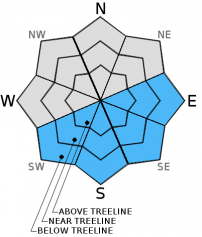| Sunday | Sunday Night | Monday | |
|---|---|---|---|
| Weather: | Partly cloudy skies. | Partly cloudy skies, becoming clear. | Sunny skies. |
| Temperatures: | 43 to 50 deg. F. | 26 to 34 deg. F. | 46 to 53 deg. F. |
| Mid Slope Winds: | N to NE | NE | E |
| Wind Speed: | 10 to 15 mph, increasing to 15 to 25 mph with gusts to 35 mph in the afternoon. | 15 to 25 mph with gusts to 35 mph. | 10 to 15 mph. Gusts up to 25 mph in the morning. |
| Expected snowfall: | 0 | 0 | 0 |
| Sunday | Sunday Night | Monday | |
|---|---|---|---|
| Weather: | Partly cloudy skies. | Partly cloudy skies, becoming clear. | Sunny skies. |
| Temperatures: | 39 to 46 deg. F. | 24 to 31 deg. F. | 43 to 50 deg. F. |
| Ridge Top Winds: | N to NE | NE | E |
| Wind Speed: | 15 to 20 mph with gusts to 30 mph, increasing to 20 to 30 mph with gusts to 45 mph in the afternoon. | 25 to 30 mph with gusts to 50 mph, decreasing to 20 to 25 mph with gusts to 40 mph after midnight. | 15 to 20 mph with gusts to 30 mph. |
| Expected snowfall: | 0 | 0 | 0 |























